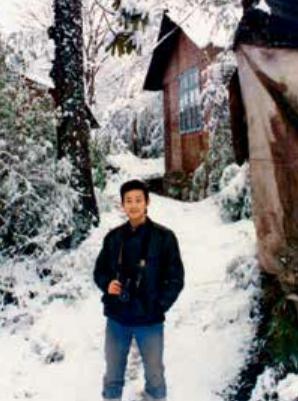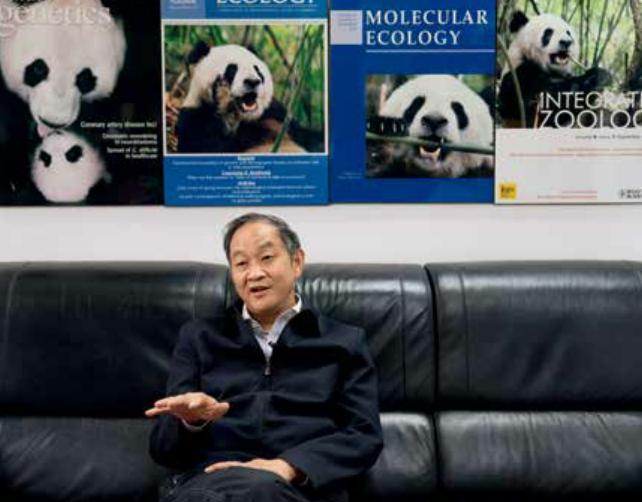Wei Fuwen Learn from the Panda
2019-06-04byHuZhoumeng
by Hu Zhoumeng
Across more than eight million years of evolution, how did the seemingly clumsy giant panda survive the jaws of extinction while other powerful animals of the period, such as the saber-toothed tiger and the mammoth, died out? From Ailurarctos lufengensis to Ailuropoda microta, then to Ailuropoda melanoleuca baconi and finally to the modern giant panda, its evolution process has drawn great interest from countless biologists. Wei Fuwen, an academician at the Institute of Zoology of the Chinese Academy of Sciences (CAS), is one of them.
Over the past three decades, Wei trekked dense forests and steep mountains in the habitats of giant pandas to research their habits and traits. Using advanced research methods and theories such as population genomics and metagenomics, he gradually solved mysteries about the animals evolution. In his eyes, the panda is clumsy but adorable, and has many things worth learning for humans.
“We humans should constantly change like giant pandas have done to adapt to the changing natural environment and society and survive.”
Foundational Work
Since French missionary Armand David first discovered the giant panda in Chinas Sichuan Province in 1869, the cuddly animal has won adoration and curiosity from people around the world. At first, biologists studied the giant panda from the perspectives of morphology and morphological anatomy, and gained knowledge about its physical structure as well as the functions and structures of its organs and tissues. However, debates on the speciation of the giant panda persisted for more than 100 years.
“Not until the mid-1980s did scientists confirm that the giant panda belongs to the Ursidae family and has a close connection to the Andean bear of South America,” Wei said.
Wei himself joined research of giant pandas in the mid-1980s. In 1984 before he graduated from the Department of Biology of Nanchong Normal University(todays China West Normal University), Wei became one of the first masters degree students of Professor Hu Jinchu, who is considered the “first Chinese person to study the giant panda.”
Over the following decade as he worked on his masters degree and then stayed at the university as a researcher, Wei trekked almost every mountain in Sichuan to research giant pandas. He worked at numerous observation stations including those at Wuyipeng and Baixiongping. In 1994, Wei was admitted to the doctoral program at the CAS Institute of Zoology. He gradually dove deeper into research of the giant panda.
“In the past, we had already found some important hints about the pandas adaptive evolution, but hadnt tried to explain them systematically,” Wei recalled. How did the giant panda evolve from a carnivorous or omnivorous animal to a vegetarian feeding exclusively on bamboo? Given that the giant panda doesnt produce digestive enzymes for cellulose, how does it digest bamboo fiber? Why did the giant panda develop a pseudothumb? Such questions inspired Wei to find answers through innovative research.
In recent years, Wei led a team to determine the basal metabolic rate of the giant panda with the doubly labeled water method. They found that the pandas basal metabolic rate is only 37.7 percent of that of other mammals with the same weight.“Its basal metabolic rate is even lower than that of the koala and close to that of the sloth,” said Wei. According to him, the giant pandas low basal metabolic rate can be attributed to its relatively shrunken organs, less activity and low thyroid hormone level. “Its DUOX2 gene, which is crucial for thyroid hormone synthesis, mutated. This is probably why the giant panda maintains a relatively low thyroid hormone level.” Moreover, the giant pandas thick fur keeps the animal dry and warm, cutting energy loss.
In the future, Wei and his team will determine the reason behind the embryonic diapause of the giant panda. Wild pandas mate in spring, but instead of immediately implanting in the uterus, the embryonic blastocyst remains suspended until June or July. So far, the cause of the phenomenon remains unknown.“Only challenging problems inspire my passion and interest,” Wei said.
“Some research projects are difficult and produce few results even after years of effort. Nevertheless, they are still worth doing.”
No Dead Ends
Many were once pessimistic about the future of the giant panda. News reports such as “Parasitic worm presents panda threat” and“Blossoming bamboo results in starvation of giant pandas” often appeared in headlines. In Weis opinion, however, such worries were unfounded.
“By studying the excrement of wild giant pandas, we found that up to 70 percent of them were infected by ascariasis, but the diseases fatality rate wasnt as high as we thought,” Wei explained. “Some believe that pandas will starve to death when bamboo blooms into flowers. In fact, bamboo blossoms once every 30 to 80 years. Bamboo has blossomed many times throughout history, but the giant panda hasnt gone extinct yet.”
Wei believes that the giant panda has a bright future ahead. His research proves that evolution of the animal has never actually ceased. Through using molecular scatological and genomic research methods to analyze wild pandas droppings, hair, tissue, blood and fur discovered in six mountain ranges, his team found that the gene heterozygosity of the giant panda is 10 times that of the snub-nosed monkey. Compared to other bears, the giant panda has relatively high genetic diversity and a greater potential for sustainable evolution. Even giant pandas in captivity have similar genetic diversity to those living in the wild.
Today, China has established 67 giant panda nature reserves, covering 55 percent of panda habitats and more than 65 percent of the wild panda population. The country is planning to set up a giant panda national park to expand the conservation scope for wild pandas. The Fourth National Giant Panda Survey in 2014 showed that China had 1,864 wild pandas, a sharp increase from the figure of the third survey conducted 10 years earlier. In September 2016, the International Union for Conservation of Nature announced that the giant pandas status had been downgraded from“endangered” to “vulnerable.”According to Wei, this marked the international community recognizing the Chinese governments effort to protect the species.
“The giant pandas population and habitat area are both increasing, and China has raised a banner for international efforts in biodiversity protection,” remarked Wei.“However, that doesnt mean we can ease up on our conservation efforts for the animal.” Based on his genomic analysis of the giant panda, Wei concluded that the fragmentation of their habitats has impeded migration of wild pandas and gene flow between different panda communities, resulting in genetic divergence. Some small subpopulations are even on the verge of extinction. In this context, he actively calls for building ecological corridors and freeing captive pandas into the wild. Currently, several ecological corridors are in planning or under construction in giant panda habitats in the Daxiangling and Minshan mountain ranges. A giant panda named Luxin successfully gave birth to a cub after returning to the wild, leaving researchers with great hope.
“Research and conservation are not independent—they work hand in hand,” declared Wei. “The giant panda species has a bright future, and through careful protection by mankind, the animal will definitely coexist in harmony with us for a long time.”